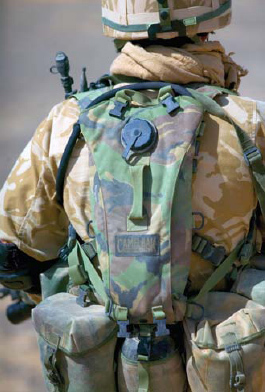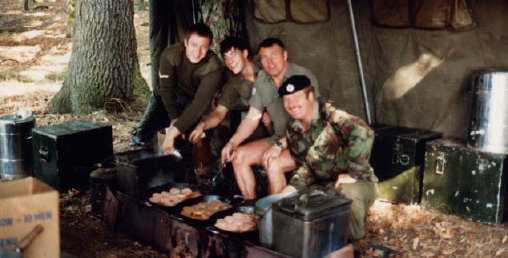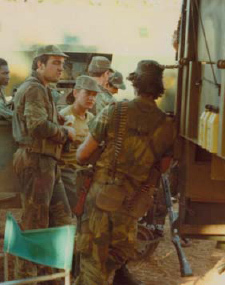The way you will find water is to find people. And ask them. All people the world over need to drink regularly and set their lives up accordingly. The locals will know where the water is for sure. Although in many third world countries the women still have to walk miles each day to fetch the family’s water in a tin can carried on their head so don’t expect it to be close.

Soldier with a CamelBak, a handy piece of modern kit. (Mike Weston © UK Crown Copyright, 2005, MOD)
It is up to your discretion how firmly you ask for water. Absolutely always make sure the locals drink first. However much they smile while you have a gun in your hand, the locals in many areas you are operating in will hate your guts and will kill you given half a chance.
Then wait for a while and then use anti-bug tablets (see below) on the water. Although the water may still look yellow and muddy, and smell like it has just squirted out of someone with dysentery, when the pills have done their mojo it will do you no harm. If you think you would never drink water like this, then you have never been hungry or thirsty for a few days – your pickiness diminishes no end after a while in the sun with no water.
The locals in many places are amazingly tough and tolerant of contamination which would kill Westerners or at the best leave us stuck in the latrine for days. So be careful what you drink. Where possible try to eat the local fruit such as melons to top up your supply of liquid. Even where the water is poisoned or contaminated the fruit will be ok – providing it hasn’t been tampered with.
Water sterilization tablets
On a long patrol you might have to drink some pretty questionable water. Boiling water, contrary to popular myth, does not always kill all the bugs in it. It certainly doesn’t get rid of poison. Besides rat poison additives – warfarin – water can carry germs for a thousand diseases including cholera, worms and other creatures which will make a home in your belly and eat you from the inside. There is a bug in West Africa which turns your insides to a bloody soup that runs out through all your holes; and it kills everyone that gets it in a couple of days.
The water sterilization tablets will kills all the germs, parasites and bugs in the water so, when you have assured yourself as best you can that the water is not poisoned fill a bottle and add the sterilization tablets in the recommended amounts. If you are not in a hurry, draw straws for someone to try the water first and wait a few hours for results or the lack thereof.
FOOD FROM THE QUARTERMASTER
It’s traditional to complain about army food. You are not the first and will certainly not be the last. Soldiers have complained for thousands of years and they are not about to stop any time soon. The fact is, your mother has spoiled you rotten and whatever the army chefs cook up you are going to complain. And if you are pissed off with being away from your girl then the food is as good a thing as anything else to complain about.

British Army field kitchen – hot food is always good for morale. Unfortunately you are unlikely to enjoy such luxuries when on extended SF patrols behind enemy lines. (Photo courtesy Sergeant Roy Mobsby)
But remember: while you are in camp you are going to be waited on hand and foot with nourishing, cooked food supplied hot and ready to eat in huge quantities by happy smiling cooks. OK, maybe the cooks are mouthy sods with a bad attitude but you get the idea.
Why do you need to eat?
This sounds a pretty stupid question but you may not have thought about the answer. We use food to generate heat and keep our body at the right temperature, to give us energy and to repair damage to our body.
There are four main food types and they are useful in different ways from a soldier’s point of view. All these food types can be broken down by your body to give you energy for heat and movement. The amount of energy available from each food can be measured and expressed as calories per weight. Some foods have far more calories than others for the same amount and are therefore compact sources of energy. Chocolate is at the top with breads and similar a little further down the list. If you are an expert then you will realize I am putting this simply:
Sugars: All food is broken down to a simple sugar before it is burnt as energy. If you eat sugary food then this will break down quickly and easily to give you a quick burst of energy or recover your losses to some extent. Besides chocolate bars of many kinds, you can buy bars of solid sugar flavoured with mint as an energy boost and some units supply sugar pills – which we used to call K pills from the fanciful idea that each pill kept you going another kilometre.
Carbohydrates: Bread, biscuits, pasta etc are rich in carbs and these are your main source of energy. They break down slowly in your body and release energy to keep you going for the long haul. If you have a long march to do eat plenty of carbs the night before. Of course, if you eat too many carbs they don’t get used and are then stored as fat.
Protein: Meat is the most convenient source of protein. Contrary to what most people think, protein is most important for growth and repair of the body rather than energy so adults don’t need a great deal. Aside from the small amount we use to repair our muscles after exercise, the remainder is broken down to provide energy in a similar way to carbs but with slightly more difficulty for the body.
Fats: Despite the common belief that fats make you fat, they don’t – at least no more than carbs do. Fats such as cooking oil and the fat in meat and other dishes are packed full of calories which will break down slowly and give you long-term energy for action or heat. Eskimos eat massive amounts of fat from the animals they hunt and their bodies use it to keep warm in the Arctic. And you don’t often see a fat Eskimo.
Keeping warm
In cold climates we use a great deal of our food to keep our bodies at their operating temperature. This is why we generally feel hungry and fancy heavy, carb-rich food like stew in the winter. If it is cold where you are working then you will need more food than when it is warm weather just to keep yourself warm.
Energy
The way the body breaks down food and turns it to energy is far too complicated to explain here. Put simply, you have a certain amount of ready-use energy fuel in your muscles and blood. You use this when you exercise or do a march. When you are tired this supply is used up and the waste product, lactic acid, is held in your muscles and will later lead to stiffness. This is why you should warm down after exercise to flush out the lactic acid with fresh blood.
After a long period of exercise which has depleted your ready-use fuel reserves it takes your body some hours to replenish them and this is why you need a rest for the best part of a day before you are ready to perform again to the same standard in a march or other exercise. Some people’s bodies replenish the ready-use fuel more quickly than others and therefore they recover more quickly. This is the reason, on a long patrol or series of selection marches, why some people who may be fit and athletic gradually lose condition day by day – their body is not resupplying fuel quickly enough to keep up. This principle is also why some people have more stamina than others.

The Author, left, grabbing a sandwich and catching up with the lads back at base camp. Refuel with food whenever you get the opportunity. (Author’s Collection)